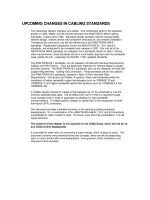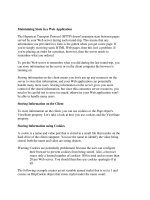Tài liệu Managing time in relational databases- P6 pptx
Bạn đang xem bản rút gọn của tài liệu. Xem và tải ngay bản đầy đủ của tài liệu tại đây (299.76 KB, 20 trang )
representing that object during some period of its existence. The
one non-temporal row, and the set of version rows, cover exactly
the same period of time.
But basic versioning is the least frequently used kind of
versioning in real-world databases. The reason is that it pre-
serves a history of changes to an object for only as long as the
object exists in the database. When a delete transaction for the
object is applied, all the information about that object is
removed.
One type of versioning that is frequently seen in real-world
databases is logical delete versioning. It is similar to basic
versioning, but it uses logical deletes instead of physical deletes.
As a result, the history of an object remains in the table even
after a delete transaction is applied.
Logical Delete Versioning
In this variation on versioning, a logical delete flag is included
in the version table. It has two values, one marking the row as
not being a delete, and the other marking the row as being a
delete. We will use the values “Y” and “N”.
After the same insert and the same update transactions, our
non-temporal and logical delete version tables look as shown
in Figure 4.5.
We are now at one clock tick before December 2010, i.e. at
N
ovember 2010. Although
we have chosen to use a one-month
clock in our examples primarily because a full timestamp or
even a full date would take up too much space across the width
Nov10
Jan
2014
Jan
2013
Jan
2012
Jan
2011
Jan
2010
BK
BK
P861
P861
P861
P861 Aug10
May10
Jan10
ver-dt
C882
C882
C882
C882
PPO
PPO
HMO
HMO
$20
$20
$20
$15
Jan10
Aug10
updt-dt
crt-dt
copay
copay
del-flg
N
N
N
type
type
client
client
Figure 4.5 A Logical Delete Version Table: Before the Delete Transaction.
Chapter 4 THE ORIGINS OF ASSERTED VERSIONING: IT BEST PRACTICES
83
of the page, a 1-month clock is not completely unrealistic. It
corresponds to a database that is updated only in batch mode,
and only at one-month intervals. Nonetheless, the reader should
be aware that all these examples, and all these discussions,
would remain valid if any other granularity, such as a full
timestamp, were used instead.
Let us assume that it is now December 2010, and time to apply
the logical delete transaction. The result is shown in Figure 4.6.
H
owever,
the non-temporal table is not shown in Figure 4.6,
or in any of the remaining diagrams in this chapter, because our
comparison of non-temporal tables and version tables is now
complete.
Note that none of policy P861’s rows have been physically
remo
ved from the table. The
logical deletion has been carried
out by physically inserting a row whose delete flag is set to “Y”.
The version date indicates when the deletion took place, and
because this is not an update transaction, all the other data
remains unchanged. The logical deletion is graphically
represented by closing the open-ended rectangle.
At this point, the difference in information content between
the two tables is at its most extreme. The non-temporal table
has lost all information about policy P861, including the infor-
mation that it ever existed. The version table, on the other
hand, can tell us the state of policy P861 at any point in time
between its initial creation on January 2010 and its deletion on
December 2010.
These differences in the expressive power of non-temporal
and logical delete version tables are well known to experienced
Dec10
Jan
2014
Jan
2013
Jan
2012
Jan
2011
Jan
2010
INSERT INTO Policy (BK, ver_dt, client, type, copay, del_flg)
VALUES (‘P861’,CURRENT_DATE, ‘C882’, ‘PPO’, ‘$20’, ‘Y’ )
BK
P861
P861
P861
P861
Jan10 C882
C882
C882
C882 PPO
PPO
HMO
HMO
type copay
$15
$20
$20
$20
N
N
N
Y
del-flg
ver-dt
client
May10
Aug10
Dec10
Figure 4.6 A Logical Delete Version Table: After the Delete Transaction.
84
Chapter 4 THE ORIGINS OF ASSERTED VERSIONING: IT BEST PRACTICES
IT professionals. They are the reason we turn to such version
tables in the first place.
But version tables are often required to do one more thing,
which is to manage temporal gaps between versions of objects.
In a non-temporal table, these gaps correspond to the period
of time between when a row representing an object was deleted,
and when another row representing that same object was later
inserted.
When only one version date is used, each version for an
object other than the latest version is current from its version
date up to the date of the next later version; and the latest ver-
sion for an object is current from its version date until it is logi-
cally deleted or until a new current version for the same object is
added to the table. But by inferring the end dates for versions in
this way, it becomes impossible to record two consecutive vers-
ions for the same object which do not [meet]. It becomes impos-
sible to record a temporal gap between versions.
To handle temporal gaps, IT professionals often use two ver-
sion dates, a begin and an end date. Of course, if business
requirements guarantee that every version of an object will begin
precisely when the previous version ends, then only a single ver-
sion date is needed. But this guarantee can seldom be made; and
even if it can be made, it is not a guarantee we should rely on.
The reason is that it is equivalent to guaranteeing that the busi-
ness will never want to use the same identifier for an object
which was once represented in the database, then later on was
not, and which after some amount of time had elapsed, was
represented again. It is equivalent to the guarantee that the busi-
ness will never want to identify an object as the reappearance of
an object the business has encountered before.
Let’s look a little more closely at this important point. As diffi-
cult as it often is, given the ubiquity of unreliable data, to support
the concept of same object, there is often much to be gained. Con-
sider customers, for example. If someone was a customer of ours,
and then for some reason was deleted from our Customer table,
will we assign that person a new customer number, a new identi-
fier, when she decides to become a customer once again? If we do
so, we lose valuable information about her, namely the informa-
tion we have about her past behavior as a customer. If instead
we reassign her the same customer number she had before, then
all of that historical information can be brought to bear on the
challenge of anticipating what she is likely to be interested in
purchasing in the near future. This is the motivation for moving
beyond logical delete versioning to the next versioning best prac-
tice—temporal gap versioning.
Chapter 4 THE ORIGINS OF ASSERTED VERSIONING: IT BEST PRACTICES
85
Temporal Gap Versioning
Let’s begin by looking at the state of a temporal gap version
table that would have resulted from applying all our transactions
to this kind of version table. We begin with the state of the table
on November 2010, just before the delete transaction is applied,
as shown in Figure 4.7.
We notice, first of all, that a logical delete flag is not present
on
the table. We will
see later why it isn’t needed. Next, we see
that except for the last version, each version’s end date is the
same as the next version’s begin date. As we explained in
Chapter 3, the interpretation of these pair of dates is that each
version begins on the clock tick represented by its begin date,
and ends one clock tick before its end date.
In the last row, we use the value 9999 to represent the highest
date the DBMS is capable of recording. In the text, we usually
use the value 12/31/9999, which is that date for SQL Server, the
DBMS we have used for our initial implementation of the
Asserted Versioning Framework. Notice that, with this value in
ver_end, at any time from August 2010 forward the following
WHERE clause predicate will pick out the last row:
WHERE ver_dt <¼ Now() AND Now() < ver_end
1
Or, at any time from May to August, the same predicate will
pick out the middle row. In other words, this WHERE clause
predicate will always pick out the row current at the time the
query containing it is issued, no matter when that is.
Figure 4.8 sho
ws how logical delet
ions are handled in tempo-
ral gap version tables.
1
We use hyphens in column names in the illustrations, because underscores are more
difficult to see inside the outline of the cell that contains them. In sample SQL, we
replace those hyphens with underscores.
Nov10
Jan
2014
Jan
2013
Jan
2012
Jan
2011
Jan
2010
BK
P861
P861
P861
Aug10
May10
Jan10
ver-dt
C882
C882
C882 PPO
HMO
HMO
type
client
copay
$15
$20
$20
9999
Aug10
May10
ver-end
Figure 4.7 A Temporal Gap Version Table: Before the Delete Transaction.
86
Chapter 4 THE ORIGINS OF ASSERTED VERSIONING: IT BEST PRACTICES
As we have seen, when an insert or update is made, the ver-
sion created is given an end date of 12/31/9999. Since most of
the time, we do not know how long a version will remain current,
this isn’t an unreasonable thing to do. So each of the first two
rows was originally entered with a 12/31/9999 end date. Then,
when the next version was created, its end date was given the
same value as the begin date of that next version.
So when applying a delete to a temporal gap version table, all
we need to do is set the end date of the latest version of the object
to the deletion date, as shown in Figure 4.8.
In fact,
although the
delete in this example takes effect as soon as the transaction is
processed, there is no reason why we can’t do “proactive deletes”,
processing a delete transaction but specifying a date later than the
current date as the value to use in place of 12/31/9999.
Effective Time Versioning
The most advanced best practice for managing versioned data
which we have encountered in the IT world, other than our own
early implementations of the standard temporal model, is effective
time versioning. Figure 4.9 sh
ows the sc
hema for effective time
versioning, and the results of applying a proactive insert, one
which specifies that the new version being created will not take
effect until two months after it is physically inserted.
Effective time versioning actually supports a limited kind of
bi-temp
orality. As we will
see, the ways in which it falls short
of full bi-temporality are due to two features. First, instead of
adding a second a pair of dates to delimit a second time period
Dec10
Jan
2014
Jan
2013
Jan
2012
Jan
2011
Jan
2010
UPDATE Policy
WHERE BK = ‘P861’ AND ver_beg = ‘Aug10’
SET ver_end = ‘Dec10’
ver-dt
BK
P861
P861
P861 Aug10 C882 PPO
HMO
HMO
type
$20
$20
$15
copay
ver-end
May10
Aug10
Dec10
C882
C882
client
May10
Jan10
Figure 4.8 A Temporal Gap Version Table: After the Delete Transaction.
Chapter 4 THE ORIGINS OF ASSERTED VERSIONING: IT BEST PRACTICES
87
for version tables—a time period which we call assertion time,
and computer scientists call transaction time—effective time
versioning adds a single date. Next, instead of adding this date
to the primary key of the table, as was done with the version
begin date, this new date is included as a non-key column.
With effective time versioning, the version begin and end dates
indicate when versions are “in effect” from a business point of
view. So if we used the same schema for effective time versioning
as we used for temporal gap versioning, we would be unable to
tell when each version physically appeared in the table because
the versioning dates would no longer be physical dates.
That information is often very useful, however. For example,
suppose that we want to recreate the exact state of a set of tables
as they were on March 17
th
, 2010. If there is a physical date of
insertion for every row in each of those tables, then it is an easy
matter to do so. However, if there is not, then it will be necessary
to restore those tables as of their most recent backup prior to
that date, and then apply transactions from the DBMS logfile
forward through March 17
th
. For this reason, IT professionals
usually include a physical insertion date on their effective time
version tables.
Once the proactive insert transaction shown in Figure 4.9 has
comple
ted, then at any tim
e from January 1
st
to the day before
March 1
st
, the following filter will exclude this not yet effective
row from query result sets:
WHERE ver_dt <¼ Now() AND Now()< ver_end
But beginning on March 1
st
, this filter will allow the row into
result sets. So the use of this filter on queries, perhaps to create a
dynamic view which contains only currently effective data,
makes it possible to proactively insert a row which will then
Jan10
Jan
2014
Jan
2013
Jan
2012
Jan
2011
Jan
2010
INSERT INTO Policy (BK, ver_beg, client, type, copay, ver_end, crt_dt, updt_dt)
VALUES (‘P861’, ‘Mar10’, ‘C882’, ‘HMO’, ‘$15’, ’9999’, CURRENT_DATE)
BK ver-dt
P861 Mar10 C882 HMO $15 9999 Jan10 {null}
updt-dt
crt-dtver-end
copaytype
client
Figure 4.9 Effective Time Versioning: After a Proactive Insert Transaction.
88
Chapter 4 THE ORIGINS OF ASSERTED VERSIONING: IT BEST PRACTICES
appear in the current view exactly when it is due to go into
effect, and not a moment before or a moment after. The time
at which physical maintenance is done is then completely inde-
pendent of the time at which its results become eligible for
retrieval as current data.
Proactive updates or deletes are just as straightforward. For
example, suppose we had processed a proactive update and then
a proactive delete in, respectively, April and July. In that case, our
Policy table would be as shown in Figure 4.10.
To see how three transactions resulted in these two versions,
let’
s read the histor
y of P861 as recorded here. In January, we
created a version of P861 which would not take effect until
March. Not knowing the version end date, at the time of the
transaction, that column was given a value of 12/31/9999. In
April, we created a second version which would not take effect
until May. In order to avoid any gap in coverage, we also updated
the version end date of the previous version to May. Not knowing
the version end date of this new version, we gave it a value of
12/31/9999.
Finally, in July, we were told by the business that the policy
would terminate in August. Only then did we know the end date
for the current version of the policy. Therefore, in July, we
updated the version end date on the then-current version of
the policy, changing its value from 12/31/9999 to August.
Effective Time Versioning and Retroactive Updates
We might ask what kind of an update was applied to the first
row in April, and to the second row in July. This is a version table,
and so aren’t updates supposed to result in new versions added
to the table? But as we can see, no new versions were created
on either of those dates. So those two updates must have
overwritten data on the two versions that are in the table.
There are a couple of reasons for overwriting data on vers-
ions. One is that there is a business rule that some columns
should be updated in place whereas other columns should be
versioned. In our Policy table, we can see that copay amount is
one of those columns that will cause a new version to be created
BK
P861
P861 May10
Mar10
C882
C882 HMO
HMO
type copay
$15
$20 Aug10
May10
ver-end crt-dt
Jan10
Apr10 Jul10
Apr10
updt-dtver-dt
client
Figure 4.10 Effective Time Versioning: After Three Proactive Transactions.
Chapter 4 THE ORIGINS OF ASSERTED VERSIONING: IT BEST PRACTICES
89
whenever a change happens to it. But we may suppose that there
are other columns on the Policy table, columns not shown in the
example, and that the changes made on the update dates of
those rows are changes to one or more of those other columns,
which have been designated as columns for which updates will
be done as overwrites.
The other reason is that the data, as originally entered, was in
error, and the updates are corrections. Any “real change”, we may
assume, will cause a new version to be created. But suppose we
aren’t dealing with a “real change”; suppose we have discovered
a mistake that has to be corrected. For example, let’s assume that
when it was first created, that first row had PPO as its policy type
and that, after checking our documents, we realized that the cor-
rect type, all along, was HMO. It is now April. How do we correct
the mistake?
We could update the policy and create a new row. But what
version date would that new row have? It can’t have March as
its version date because that would create a primary key conflict
with the incorrect row already in the table. But if it is given April
as its version date, then the result is a pair of rows that together
tell us that P861 was a PPO policy in March, and then became an
HMO policy in April. But that’s still wrong. The policy was an
HMO policy in March, too.
We need one row that says that, for both March and April,
P861 was an HMO policy. And the only way to do that is to over-
write the policy type on the first row. We can’t do that by creating
a new row, because its primary key would conflict with the pri-
mary key of the original row.
Effective Time Versioning and Retroactive Inserts
and Deletions
Corrections are changes to what we said. And we have just
seen that effective time versioning, which is the most advanced
of the versioning best practices that we are aware of, cannot
keep track of corrections to data that was originally entered in
error. It does not prevent us from making those corrections.
But it does prevent us from seeing that they are corrections,
and distinguishing them from genuine updates.
Next, let us consider mistakes made, not in the data entered,
but in when it is entered. For example, consider the situation in
which there are no versions for policy P861 in our version table,
and in which we are late in performing an insert for that policy.
Let’s suppose it is now May, but that P861 was supposed to take
90
Chapter 4 THE ORIGINS OF ASSERTED VERSIONING: IT BEST PRACTICES









